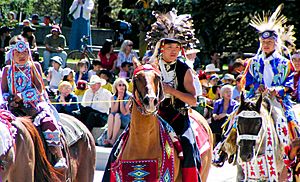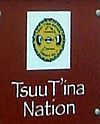Tsuu T'ina 145 facts for kids
Quick facts for kids
Tsuu T'ina Nation 145
tsúùtʾínà
|
||
|---|---|---|
| Tsuu T'ina Nation Indian Reserve No. 145 | ||
|
||
|
Location of Tsuu T'ina Nation 145 relative to Calgary
|
||
| Country | ||
| Province | ||
| Region | Calgary Region | |
| Census division | 6 | |
| Area | ||
| • Total | 283.14 km2 (109.32 sq mi) | |
| Elevation | 1,160 m (3,810 ft) | |
| Population
(2011)
|
||
| • Total | 2,052 | |
| • Density | 7.2/km2 (19/sq mi) | |
| Time zone | UTC−7 (MST) | |
| • Summer (DST) | UTC−6 (MDT) | |
| Forward sortation areas |
T3T
|
|
| Highways | Highway 22X, Highway 201 | |
Tsuu T'ina Nation 145 (Sarsi: tsúùtʾínà) is an Indian reserve in southern Alberta, Canada. It belongs to the Tsuutʼina Nation and was created by Treaty 7.
The reserve is located near the city of Calgary. It borders Calgary to the northeast, east, and southeast. To the south, it borders the Municipal District of Foothills No. 31. Rocky View County is to its west and north. The reserve is surrounded by major roads like Tsuut'ina Trail and Highway 22. The small community of Bragg Creek is also close by.
Contents
How Many People Live Here?

In 2011, the Tsuut'ina Nation 145 had a population of 2,052 people. They lived in 630 homes. The land area of the reserve is about 283.18 square kilometers (109.34 square miles). This means there were about 7.2 people living in each square kilometer.
Here's how the population has changed over time:
- Population in 2011: 2,052
- Population in 2001: 1,982
- Population in 1996: 1,509
Working with Other Governments
The Tsuut'ina Nation works closely with nearby cities and governments. This helps everyone in the region.
Building Stronger Relationships
Leaders from the Tsuut'ina Nation often meet with the mayor of Calgary. They talk about how to help their communities grow. For example, they have discussed how to share important services like emergency medical services, police, and fire protection. These talks have helped build a stronger friendship between the Nation and Calgary.
Sharing Important Services
Calgary has agreed to provide water services to the Tsuut'ina Nation. This helps the Grey Eagle Casino expand. In the future, these water services might also be extended to other parts of the Tsuut'ina community.
Police Working Together
Since 2013, the Tsuut'ina Police and the Calgary Police have worked together. They share their knowledge and improve how they communicate. This helps keep both communities safe.
Important Developments and History
The Tsuut'ina Nation has a rich history and has seen many important changes.
Glenmore Reservoir Land Claims
The Tsuut'ina Nation and the Canadian government settled a long-standing issue in 2013. This was about land that was flooded to create the Glenmore Reservoir in 1930. The government paid the Nation $20 million as compensation. Half of this money went to the community, and the rest was shared among the members of the Nation.
Grey Eagle Casino and Hotel
In 2007, the Tsuut'ina Nation built the Grey Eagle Casino. It is located on land that used to be a military base. This land was returned to the Nation in 1996.
The casino has grown a lot. In 2012, they started building a hotel and event center. These new facilities opened in 2014. The casino is an important business for the Nation.
Former Military Land: Harvey Barracks
For many years, a part of the Tsuut'ina land was leased to the Canadian military. From 1901 to 1996, it was used to train soldiers. This area was called "Camp Harvey."
The Tsuut'ina Nation got this land back in 2006. Before it was returned, the Canadian government spent 15 years cleaning up the area. They removed old military items that could be dangerous, like old shells and grenades. About 12,000 acres of land were returned to the Nation.
Cleaning Up Old Explosives
In 1986, the Tsuut'ina Nation started its own company to clean up dangerous old explosives. It's called the "Wolf's Flat Ordnance Disposal Corp." This company was created after a sad accident in the 1950s. A grandmother and her grandchildren were hurt when an old explosive went off. The company is named after a respected elder. This company is now known worldwide for its important work. Even after many years of cleanup, old explosives are sometimes still found, especially after floods.
Black Bear Crossing Community
After the military left in 1996, some of the empty army houses became a new neighborhood called Black Bear Crossing. In 1998, many Nation members who needed homes moved into these vacant houses.
At first, there were worries about the safety of these buildings. Some thought there might be dangerous materials like asbestos, and old explosives could still be nearby. However, the government later said there was no danger from asbestos. This area grew into a community of 800 people.
In 2006, health officials said the buildings were no longer safe to live in. The tribal council then ordered everyone to move out. The houses were taken down in 2009.
The Calgary Ring Road
Alberta Transportation has wanted to build a part of Calgary's ring road, called Stoney Trail, across the Tsuut'ina reserve for a long time. This road would help reduce traffic in Calgary, especially near the Glenmore Reservoir.
Building the road through the reserve was a big decision. Some people worried about the environment. There had been many discussions about this project since the early 1990s.
In 2009, the Nation voted against giving up land for the road. But discussions started again in 2011.
Finally, on October 24, 2013, the Tsuut'ina Nation members voted to accept an offer from the Province of Alberta. They agreed to trade 428 acres of their land for 2,160 acres of new land. The Nation also received $66 million for relocation help and an additional $275 million. Chief Roy Whitney and Premier Alison Redford signed the agreement in November 2013.
The decision was difficult because it meant moving some people and homes. Also, the road would cut through beautiful and important farming land. However, Chief Roy Whitney hoped the road would bring new developments that could help the Nation, like the Grey Eagle Casino resort.
The section of the ring road that goes through the former reserve land was renamed Tsuut'ina Trail. It opened in the fall of 2020.
Taza Development
Taza is a large new development on Tsuut'ina Nation land. It covers over 1,200 acres and is right next to Calgary.
On August 28, 2020, Costco opened its first store on First Nations land here. This store is part of "The Shops at Buffalo Run," which is in the Taza Exchange area. Taza is planned to have three main parts: Taza Park, Taza Crossing, and Taza Exchange.
Education
The Tsuut'ina Nation 145 has three schools for its children:
- Chiila Elementary School
- Chief Big Belly Middle School
- Many Horses High School
All these schools are managed by Tsuut'ina Education.



